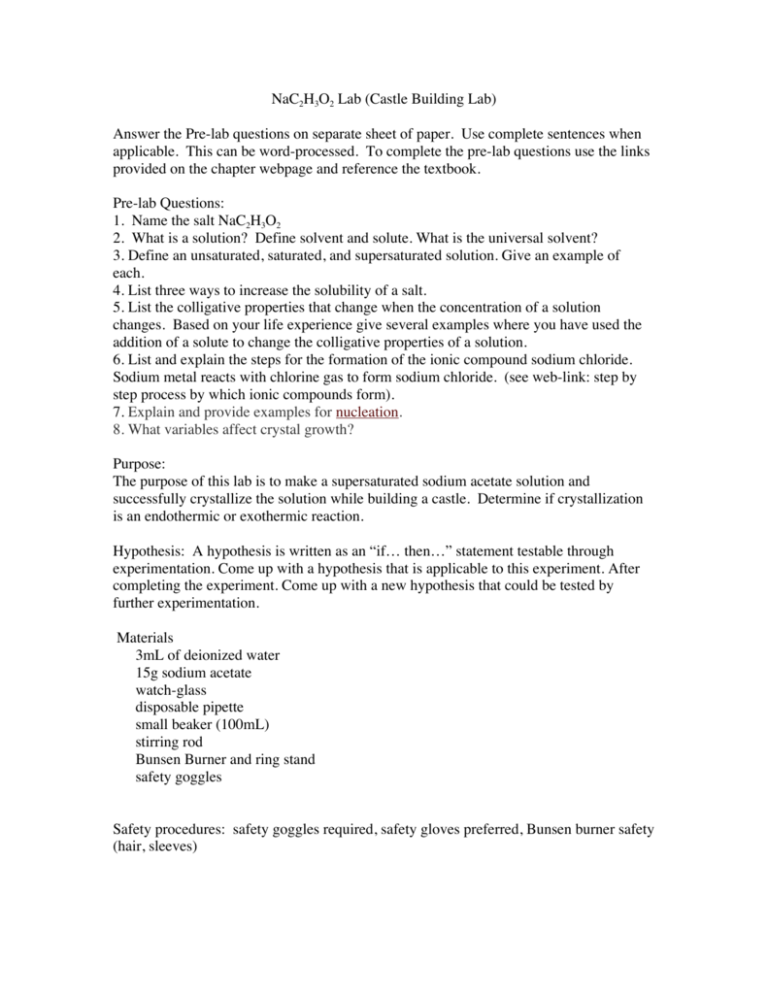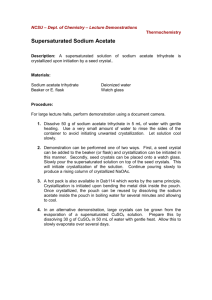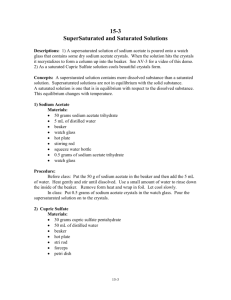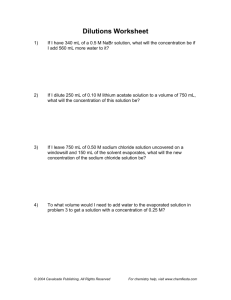NaC2H3O2 Lab (Castle Building Lab) Answer the Pre
advertisement

NaC2H3O2 Lab (Castle Building Lab) Answer the Pre-lab questions on separate sheet of paper. Use complete sentences when applicable. This can be word-processed. To complete the pre-lab questions use the links provided on the chapter webpage and reference the textbook. Pre-lab Questions: 1. Name the salt NaC2H3O2 2. What is a solution? Define solvent and solute. What is the universal solvent? 3. Define an unsaturated, saturated, and supersaturated solution. Give an example of each. 4. List three ways to increase the solubility of a salt. 5. List the colligative properties that change when the concentration of a solution changes. Based on your life experience give several examples where you have used the addition of a solute to change the colligative properties of a solution. 6. List and explain the steps for the formation of the ionic compound sodium chloride. Sodium metal reacts with chlorine gas to form sodium chloride. (see web-link: step by step process by which ionic compounds form). 7. Explain and provide examples for nucleation. 8. What variables affect crystal growth? Purpose: The purpose of this lab is to make a supersaturated sodium acetate solution and successfully crystallize the solution while building a castle. Determine if crystallization is an endothermic or exothermic reaction. Hypothesis: A hypothesis is written as an “if… then…” statement testable through experimentation. Come up with a hypothesis that is applicable to this experiment. After completing the experiment. Come up with a new hypothesis that could be tested by further experimentation. Materials 3mL of deionized water 15g sodium acetate watch-glass disposable pipette small beaker (100mL) stirring rod Bunsen Burner and ring stand safety goggles Safety procedures: safety goggles required, safety gloves preferred, Bunsen burner safety (hair, sleeves) This experiment runs a high risk of crystallizing before intended. Therefore, all equipment must be clean and take precautions to not expose the super saturated solution to any contaminants. How it works: Sodium acetate can dissolve in water in great quantities at high temperature, and if you let the solution cool carefully to around room temperature, you have a clear supersaturated solution. Disturbing this unstable equilibrium by dropping a small crystal of sodium acetate into the solution makes the whole thing solidify; the sodium acetate crystals growing radially outwards from the impact point of the seeding crystal. Methods 1. Measure out 15g of sodium acetate into a 100mL clean beaker or flask. 2. Measure out 3mL of deionized water using a pipette or small graduated cylinder. 3. Adjust the height of your Bunsen burner so the flame is not directly under the glass. Gently heat 15g of sodium acetate in 1mL of distilled water. Use heat to increase solubility. As the solute is dissolving you can add another mL of water to rinse down the inside of the beaker. Continue to gently heat. Use the last mL of deionized water to rinse down the inside of the beaker for the last time. When you have a clear solution turn off the heat. Make sure there are not solutes present! 4. Let the beaker cool in place. When cool you may proceed to step 5. This is a competition! Whoever builds the tallest castle wins! 5. Place a crystal of sodium acetate onto a watch-glass. (*Put a pasco temperature probe on the watch glass, hit play) *optional 6. Get a new pipette and rinse the end of the pipette with deionized water (to prevent contamination). Fill the pipette with the supersaturated sodium acetate solution (pipette must be clean or else it will activate crystallization prematurely) Using the pipette, build a sodium acetate crystal castle, by dropping the super saturated sodium acetate solution onto the sodium acetate crystal on the watch glass. Do not touch the tip of the pipette to the castle. To form “castles” build the crystals on top of one another. Continue building the castle until all the solution is gone or the castle tips over. Take a picture of the castle. Measure the height of the castle. Post lab ?’s: 1. Height of your castle in cm. 2. What happened when the supersaturated sodium acetate solution hit the watch glass? Why was a sodium acetate crystal needed to activate the crystallization? 3. Did the watch glass feel warm or cold after crystallization? *If you measured the temperature with the pasco probe then record lowest and highest temperature. 4. IF the supersaturated solution crystallized prematurely then explain why it happened and what you could of done to prevent premature crystallization. What initiated the crystallization? Explain 5. On the atomic level: describe the particles of the supersaturated solution, describe what is happening to the particles as the solution cools, and describe what happens to the particles as it crystallizes. Compare the energy of the hot and cool supersatured solution to the crystalline structure. 6. Describe the entropy of the super saturated solution and solid crystalline structure 7. Explain a supersaturated solution and how to make it. Provide examples of supersaturated solutions (real world applications) and their purpose (Research). 8. Watch the Video Crystallization of supercooled water and explain how it relates to the lab. 9. Mexico's cave of crystals. Research and explain the importance of Mexico's cave of crystals either by viewing the video(The video is long but interesting) or use resource(s) of your choosing. Cite your source. See CH7 opener. 10. Further knowledge leads to more questions. What questions came about throughout this process? If you are not questioning then you are not practicing science. Using this experiment as a starting point what would you do next to further study crystallization?





